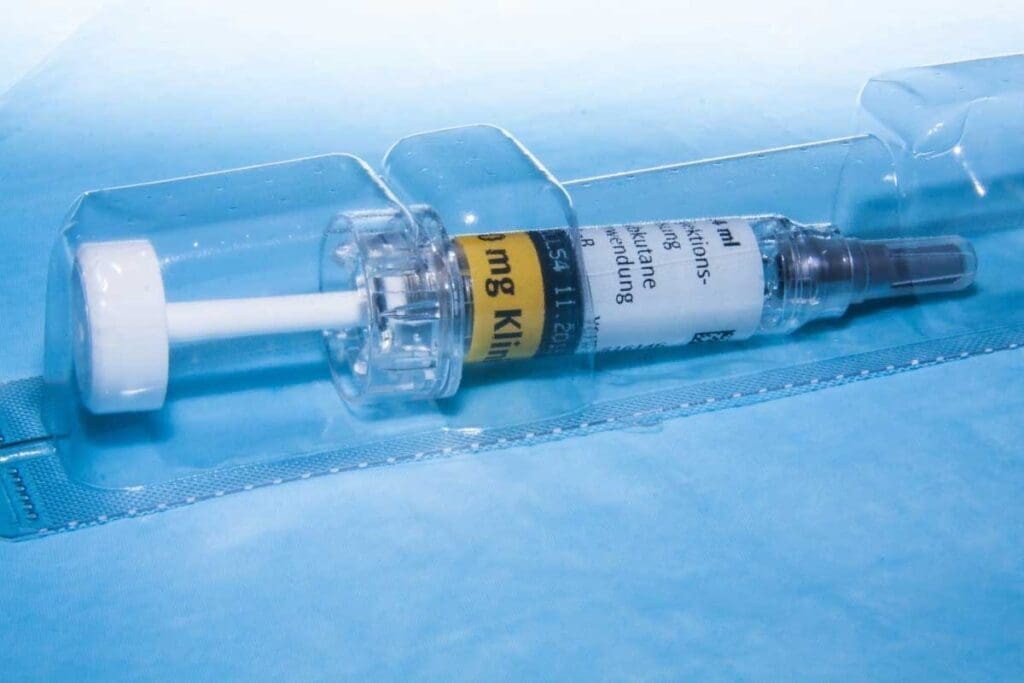Last Updated on November 17, 2025 by Ugurkan Demir
At LivHospital, we know how vital it is to stop dangerous blood clots. Enoxaparin injection, a blood thinner injection given as a shot under the skin (usually in the stomach), is a widely trusted medicine used to prevent and treat harmful clots. It helps reduce the risk of deep vein thrombosis (DVT) and pulmonary embolism (PE), especially in patients after major surgeries or those with limited mobility. Enoxaparin works by blocking substances in the blood that form clots, ensuring safer recovery and preventing serious complications like strokes or heart attacks. Patients typically receive these shots once or twice daily as prescribed by their doctor, with treatment duration depending on their risk factors.

Enoxaparin helps stop clots in the leg for those who are bedridden or having hip, knee, or stomach surgery. It’s also mixed with aspirin to avoid problems from angina and heart attacks. As a low molecular weight heparin (LMWH), enoxaparin stops clots from forming. This makes it a key drug for those at risk.
Enoxaparin is a low molecular weight heparin used in medicine. It helps prevent blood clots, which is key for patients having major surgeries.
Low molecular weight heparins (LMWHs) are a new type of anticoagulant. Enoxaparin is a well-liked LMWH because it’s safe and works well. It’s better than unfractionated heparin because it’s more predictable.

Enoxaparin stops the coagulation process by working with antithrombin. This stops thrombin and clot formation. It helps avoid deep vein thrombosis (DVT) and pulmonary embolism (PE), which are serious.
We use enoxaparin to prevent DVT in patients having big surgeries like hip or knee replacements. It’s key in stopping blood clots in surgeries and medical care.
Enoxaparin has many benefits over other anticoagulants. It’s more reliable and safer than unfractionated heparin. It doesn’t need regular blood tests like warfarin, making it easier for everyone.
But the right anticoagulant depends on the patient and the situation. Enoxaparin is a great choice for fighting blood clots.
Enoxaparin injection is key in preventing and treating blood clots. It’s used when patients are less active due to illness. This helps lower the risk of blood clots. It’s a vital part of today’s medical care.
Enoxaparin helps prevent Deep Vein Thrombosis (DVT) after major surgeries. Patients having hip or knee replacements are at high risk. It keeps them safe after surgery.
Guidelines say to start enoxaparin 12 hours before surgery and keep it up for days after. This helps a lot in preventing DVT and its dangers.
Enoxaparin also treats DVT. It stops clots from getting bigger and new ones from forming. After, patients take oral anticoagulants to stay safe.
Research shows enoxaparin works as well as unfractionated heparin for DVT. It’s also safer and easier for patients.
Pulmonary embolism (PE) is very serious and needs quick action. Enoxaparin helps by stopping more clots and dissolving existing ones.
Studies back up using enoxaparin for PE. It’s often used until patients can take oral anticoagulants to keep them safe.
Enoxaparin helps with heart attacks and unstable angina. It lowers the chance of more heart problems. This helps patients do better.
A study comparing anticoagulants is shown in the table below:
| Anticoagulant | Primary Use | Administration Route |
| Enoxaparin | DVT prevention and treatment, PE management | Subcutaneous injection |
| Warfarin | Long-term anticoagulation | Oral |
| Unfractionated Heparin | Acute anticoagulation | Intravenous or subcutaneous |

Enoxaparin injection therapy is very useful in medicine today. It helps prevent DVT, treat it, manage PE, and care for the heart. It’s key to better patient care.
Knowing how to give a shot in the stomach is key for those using enoxaparin. Enoxaparin is injected just under the skin, usually in the stomach. This method is important for stopping blood clots.
Enoxaparin is injected subcutaneously for a reason. This way, it absorbs slowly into the blood. Subcutaneous administration keeps the drug’s level steady in the body. This helps prevent blood clots effectively.
To give enoxaparin right, follow these steps:
It’s important to change where you inject to avoid bruising and irritation. The stomach is the usual spot, but pick a different place each time. Proper injection site rotation reduces discomfort and side effects.
For those giving themselves enoxaparin, stick to the dosage and method your doctor told you. Practice makes perfect. The more you do it, the easier it gets. If you have trouble or worries, talk to your doctor.
Some important tips are:
Enoxaparin is usually safe, but patients should know about possible side effects. It’s important to take steps to avoid risks. Healthcare providers and patients must be careful to ensure treatment is safe and works well.
Injection site reactions are common with enoxaparin. These can be pain, redness, or swelling where the injection was given. Sometimes, reactions can be more serious, like bruising or a hematoma.
To reduce these reactions, it’s key to use the right injection technique. Also, change where you inject the drug regularly. Patients should learn how to give themselves the injection and watch for any bad reactions at the injection site.
Enoxaparin can increase the chance of bleeding. Look out for signs like nosebleeds, bleeding gums, or blood in urine or stool. Serious bleeding, like in the stomach or brain, can also happen.
Healthcare providers need to check if patients are at risk before starting enoxaparin. They should look at the patient’s medical history, current medicines, and lab results. Patients should know how to spot and report any bleeding.
Enoxaparin can interact with other drugs, which might increase bleeding risk or other bad effects. Tell your healthcare provider about all medicines you’re taking, including over-the-counter ones and supplements.
Some drugs that might interact with enoxaparin include other blood thinners, drugs that prevent platelets from sticking together, and certain anti-inflammatory drugs. Healthcare providers should manage these interactions to lower risks.
| Medication Class | Examples | Potential Interaction |
| Antiplatelet Agents | Aspirin, Clopidogrel | Increased bleeding risk |
| NSAIDs | Ibuprofen, Naproxen | Increased bleeding risk |
| Other Anticoagulants | Warfarin, Dabigatran | Enhanced anticoagulant effect |
It’s important to regularly check on patients taking enoxaparin. This might include blood tests to see how well the drug is working and to watch for side effects.
Healthcare providers should create a monitoring plan that fits each patient’s needs. This plan should consider the patient’s health, kidney function, and other important factors. Patients should understand why sticking to their monitoring schedule is important.
By knowing about these common side effects and safety tips, patients and healthcare providers can work together. This ensures enoxaparin is used safely and effectively for blood thinner therapy.
Enoxaparin is key for many special patient groups. Each group has its own needs and challenges. We must tailor our care to meet these unique needs.
Cancer patients face a higher risk of blood clots. Low molecular weight heparin (LMWH), like enoxaparin is a top choice for preventing and treating these clots. It’s safe and effective.
Studies show enoxaparin helps prevent blood clots in cancer patients. It does this without raising the risk of major bleeding too much. We consider several factors when using enoxaparin for cancer patients:
Elderly patients need special attention with enoxaparin. Their kidneys and body shape change with age. We look at:
Older patients with low body weight or kidney issues need extra care.
Enoxaparin is safe for pregnant women at high risk of blood clots. It’s a good choice for them.
When treating pregnant women, we focus on:
Patients with kidney problems need careful dose adjustments. This prevents enoxaparin buildup and bleeding. We check kidney function before starting treatment and watch it closely.
For severe kidney issues, we might lower the dose. Sometimes, we choose other treatments instead.
By managing enoxaparin well in special patient groups, we improve outcomes and reduce risks.
Enoxaparin is key in fighting blood clots, helping patients a lot. It’s a vital drug for stopping and treating blood clots. This shows its big role in saving lives today.
It helps prevent Deep Vein Thrombosis (DVT) after big surgeries. It also treats DVT, manages Pulmonary Embolism, and helps with heart issues. Enoxaparin is a must-have in many medical situations.
Using Enoxaparin right is important. This includes how it’s injected and where. Knowing its side effects helps doctors take better care of patients and avoid risks.
As we keep improving in medicine, Enoxaparin remains a big part of treating blood clots. It’s a key player in saving lives by preventing blood clots.
Enoxaparin injection is a blood thinner. It prevents and treats blood clots. This is for patients having major surgeries or with conditions like deep vein thrombosis (DVT) and pulmonary embolism.
Enoxaparin stops blood clots from forming. It does this by blocking the clotting process. This is through its effect on Factor Xa, a key part of clotting.
It’s mainly used to prevent DVT after big surgeries. It also treats DVT, manages pulmonary embolism, and helps with heart attacks and unstable angina.
It’s given subcutaneously for good absorption. This makes it effective in preventing and treating blood clots.
Side effects include injection site reactions like bruising and redness. There’s also a risk of bleeding, from minor to severe.
Follow dosage instructions closely. Avoid other meds that might interact with enoxaparin. Tell your doctor about any bleeding risks.
Yes, elderly patients might need dosage changes. This is because kidney function can decline with age. They should also watch for signs of bleeding or other side effects.
It can be used during pregnancy and after giving birth, but with caution. A healthcare provider should monitor closely due to the risks and benefits.
Store it in the fridge, away from light. Follow the manufacturer’s instructions for handling. This keeps it safe and effective.
If you miss a dose, take it as soon as you remember. Skip it if it’s almost time for the next one. Then, stick to your regular schedule.
Subscribe to our e-newsletter to stay informed about the latest innovations in the world of health and exclusive offers!